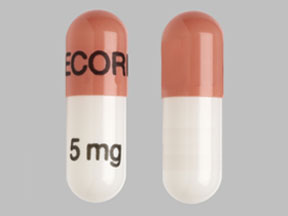Hecoria Disease Interactions
There are 7 disease interactions with Hecoria (tacrolimus).
- Diabetes mellitus
- Hepatic dysfunction
- Infections
- QT interval prolongation
- Renal dysfunction
- Hyperkalemia
- Hypertension
Tacrolimus (applies to Hecoria) diabetes mellitus
Major Potential Hazard, High plausibility.
Tacrolimus can induce post-transplant insulin-dependent diabetes mellitus (PTDM). Temporary insulin therapy has been required in some patients, while long-term insulin use has been necessary in others. Reversible insulin dependence has occurred in kidney and liver transplant patients. PTDM has occurred in a greater percentage of tacrolimus-treated (20%) versus cyclosporine-treated (4%) kidney transplant patients. Black and Hispanic patients are at increased risk for PTDM. Therapy with tacrolimus should be administered cautiously in patients with pre-transplant diabetes mellitus.
Tacrolimus (applies to Hecoria) hepatic dysfunction
Major Potential Hazard, High plausibility. Applicable conditions: Liver Disease
Tacrolimus undergoes significant hepatic metabolism, primarily by CYP450 3A enzymes. Less than 5% of tacrolimus is eliminated unchanged in the bile and <1% is eliminated unchanged in the urine. Moderate or severe hepatic dysfunction or impaired post-transplant hepatic function may alter the metabolic and therapeutic activity of tacrolimus and increase the whole blood tacrolimus concentration. Therapy with tacrolimus should be administered cautiously and dosage adjustments considered in the presence of moderate or severe hepatic impairment.
Tacrolimus (applies to Hecoria) infections
Major Potential Hazard, Moderate plausibility. Applicable conditions: Infection - Bacterial/Fungal/Protozoal/Viral, Immunodeficiency
Due to immunosuppression, patients receiving tacrolimus are at increased risk for infections, including polyoma virus infections, post-transplant lymphoproliferative disorder (PTLD) and CMV viremia and CMV disease. Polyoma virus infections in transplant patients may have serious, and sometimes fatal, outcomes. These include polyoma virus-associated nephropathy (PVAN), mostly due to BK virus infection, and JC virus-associated progressive multifocal leukoencephalopathy (PML). Cases of PML have been reported in patients treated with tacrolimus. Risk factors for PML include treatment with immunosuppressant therapies and impairment of immune function. PTLD associated with Epstein-Barr Virus (EBV), has been reported in immunosuppressed organ transplant patients. Patients that are Epstein-Barr Virus (EBV) seronegative appears to have the greatest risk of developing PTLD. It is recommended to monitor EBV serology during tacrolimus therapy. Caution and patient monitoring is recommended when using this drug in immunosuppressed patients.
Tacrolimus (applies to Hecoria) QT interval prolongation
Major Potential Hazard, Moderate plausibility. Applicable conditions: Cardiovascular Disease, Electrolyte Abnormalities, Congestive Heart Failure
Tacrolimus may prolong the QT/QTc interval and may cause Torsade de Pointes. It is recommended to avoid tacrolimus in patients with congenital long QT syndrome. In patients with congestive heart failure, bradyarrhythmias, those taking certain antiarrhythmic medications or other medicinal products that lead to QT prolongation, and those with electrolyte disturbances such as hypokalemia, hypocalcemia, or hypomagnesemia, consider monitoring of tacrolimus whole blood concentrations and obtaining electrocardiograms and monitoring electrolytes (magnesium, potassium, calcium) periodically during treatment.
Tacrolimus (applies to Hecoria) renal dysfunction
Major Potential Hazard, High plausibility.
Nephrotoxicity has been reported in 52% of kidney and 40% of liver transplant patients. Renal toxicity includes increasing serum creatinine and blood urea nitrogen, and renal failure sometimes requiring hemodialysis. Oliguria and hematuria also have been reported. The mechanism of tacrolimus-induced renal dysfunction is not well established. Renal toxicity appears to be dose-related, although toxicity may still occur even at suggested therapeutic concentrations. Therapy with tacrolimus should be administered cautiously and dosage reductions may be necessary in patients with compromised renal function. Alternative immunosuppressive therapy should be considered in the presence of persistent or worsening renal dysfunction.
Tacrolimus (applies to Hecoria) hyperkalemia
Moderate Potential Hazard, Moderate plausibility.
The use of tacrolimus has been associated with hyperkalemia. Therapy with tacrolimus should be administered cautiously in patients with elevated serum potassium levels. Close monitoring of potassium levels is recommended. Careful consideration should be given prior to use of other agents also associated with hyperkalemia (e.g., potassium-sparing diuretics, ACE inhibitors, angiotensin receptor blockers) during tacrolimus therapy.
Tacrolimus (applies to Hecoria) hypertension
Moderate Potential Hazard, Moderate plausibility.
The use of tacrolimus has been associated with hypertension. Therapy with tacrolimus should be administered cautiously in patients with elevated blood pressure. Close monitoring of blood pressure is recommended.
Hecoria drug interactions
There are 832 drug interactions with Hecoria (tacrolimus).
Hecoria alcohol/food interactions
There are 2 alcohol/food interactions with Hecoria (tacrolimus).
More about Hecoria (tacrolimus)
- Hecoria consumer information
- Check interactions
- Compare alternatives
- Reviews (1)
- Drug images
- Side effects
- Dosage information
- During pregnancy
- Drug class: calcineurin inhibitors
- Breastfeeding
Related treatment guides
Drug Interaction Classification
| Highly clinically significant. Avoid combinations; the risk of the interaction outweighs the benefit. | |
| Moderately clinically significant. Usually avoid combinations; use it only under special circumstances. | |
| Minimally clinically significant. Minimize risk; assess risk and consider an alternative drug, take steps to circumvent the interaction risk and/or institute a monitoring plan. | |
| No interaction information available. |
Further information
Always consult your healthcare provider to ensure the information displayed on this page applies to your personal circumstances.


